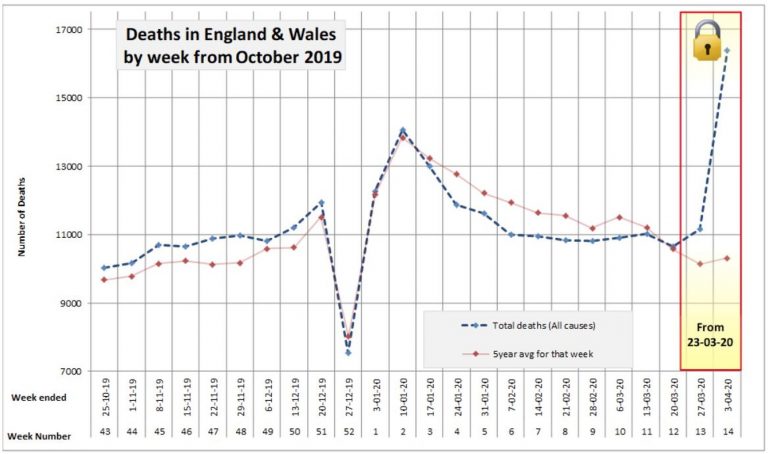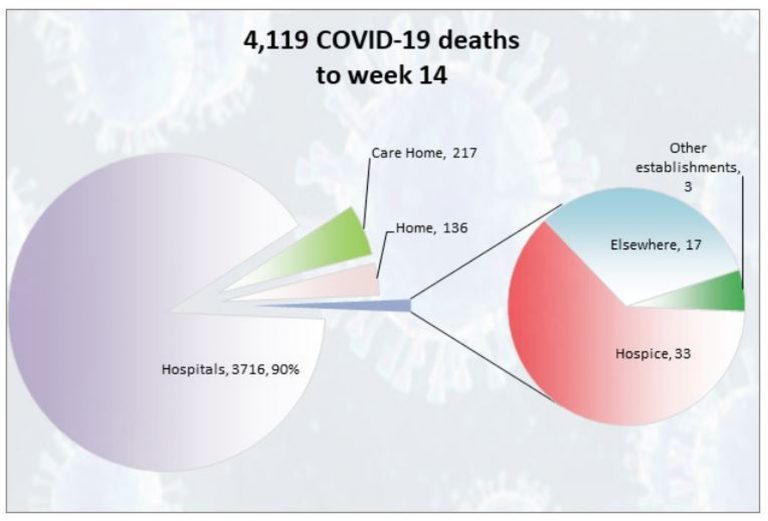Laurence Hodge has done us this graph of deaths this winter up to week 14 (click to enlarge):
You can see that there hasn’t been much in the way of excess deaths this winter (remembering that excess deaths are usually very up and down from one winter to the next). There were some extra deaths in the first few months, and then less deaths since mid-January, so we probably had quite a few people who were vulnerable.
Laurence has also sent this breakdown of where Covid-19 deaths occurred in week 14 (click to enlarge):
Officially, most Covid-19 deaths occurred in hospitals (although there is much doubt over whether the numbers in care homes really are so low). You can’t blame people for not wanting to go into hospital, when they fear getting Covid-19 while in hospital.
Unfortunately we don’t have figures on how many people went into hospital without Covid-19, and caught it in there. Those would be very interesting.
(All stats from the ONS.)


7 thoughts on “Winter 2019-20 graph, and a Covid-19 place of death graph”
“You can’t blame people for not wanting to go into hospital, when they fear getting Covid-19 while in hospital.”
This is a very real issue, there is no doubt being in a hospital exposes you to a much higher risk. It does make you wonder why this has not been something that has been managed better.
Locally we had an article by an A&E doctor that they were concerned about quiet it was and they had heard of people refusing to come in for dialysis treatments and there was a real risk of people not getting urgent care with terminal consequences.
We really have backed ourselves into a lives vs lives situation
I think the saturation media coverage, often with insufficient or no context about relative risks, and govt public information films daily are making this worse. It’s about time the govt put the same effort into reassuring the public that they should call 999 if they have a serious health problem.
If I had chest pains I’d rather take the risk of getting coronavirus in hospital against the risk of a heart attack left untreated.
The problem now of course is the hysteria that’s beginning to build around ‘the second wave’ that’s coming. I just seen no end to this pantomime anytime soon.
“(although there is much doubt over whether the numbers in care homes really are so low)”
I have a friend who manages a group of care homes. As of last week, she’d had four cases (unfortunately, I don’t know what proportion that represents, but she’s responsible for the whole South West), the first in early March before the national
paniclockdown, and none, as far as I know, fatal. To be fair, she deals more with special needs patients than the elderly, but the infection rate should at least be representative.So, while it’s certainly good to be sceptical, I don’t think the reported figures are implausible. Remember also that care homes don’t have ICUs. If a patient started showing dangerous symptoms, s/he would almost certainly be moved to a hospital. Unless we reach an Italian situation where they become overwhelmed (and, given that the hastily-built “Nightingale” hospitals are apparently practically empty, I don’t think we have), it seems perfectly reasonable that the vast majority of deaths are in hospitals.
“Unfortunately we don’t have figures on how many people went into hospital without Covid-19, and caught it in there”
I would be interested to see more information on the entire aspect of getting an infection when in hospital. It is a concern for me – here are 2 examples: 1) A friends wife went in for a tonsillectomy earlier this year, and came out with a nasty infection. Apparently, they would normally have taken her back in, but decided not to, as the CV crisis was just kicking off. 2) When attending a NHS hospital joint replacement clinic (I have a knackered hip) the surgeon told me that the biggest risk with the procedure is infection! Suffice to say, I was NOT impressed…
We seem to live in a climate of constant fear of catastrophes, and the CV second wave is just the latest installment of it. The safer our societies become the more fear about a catastrophe there seems to be.
Comments are closed.